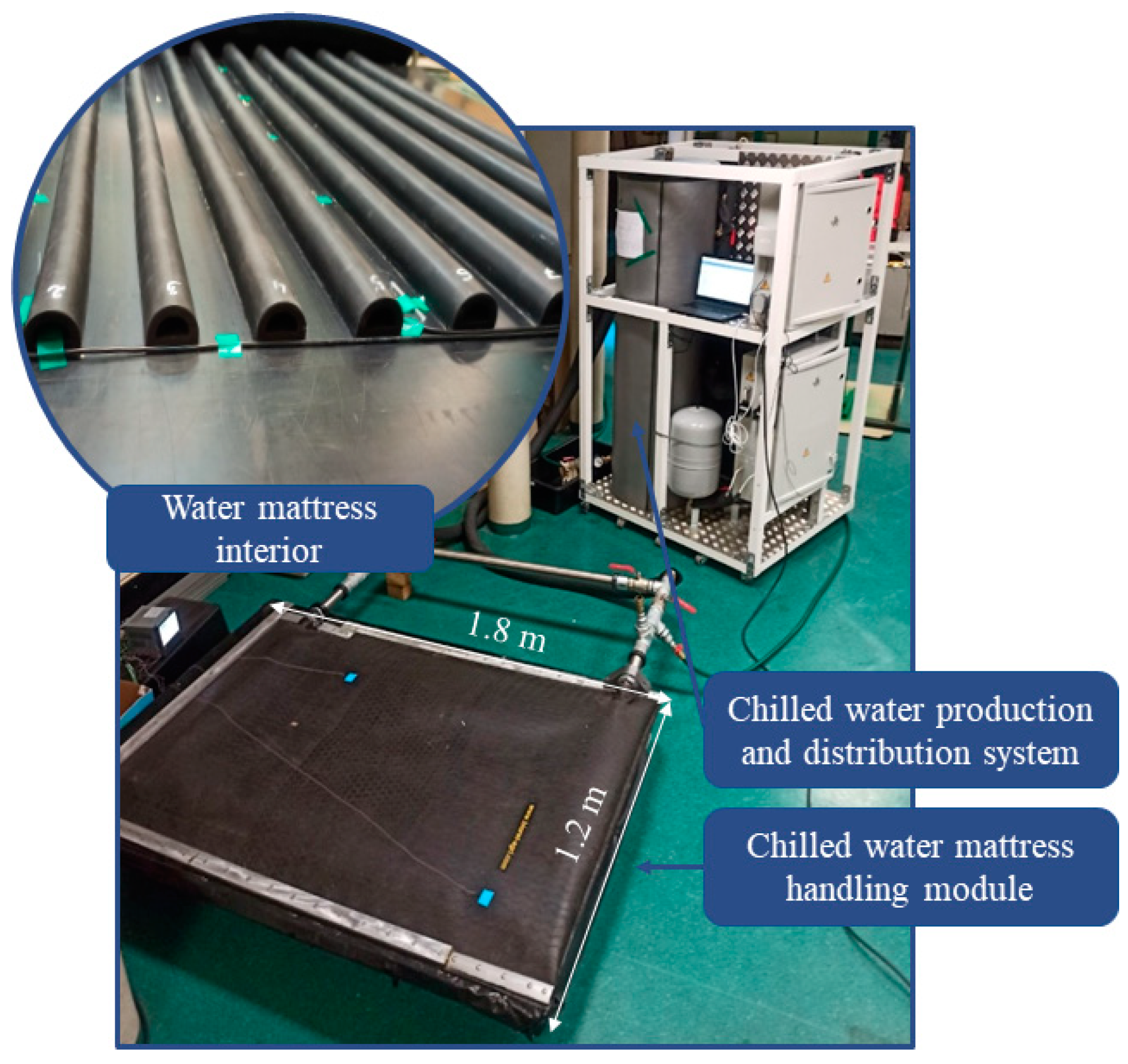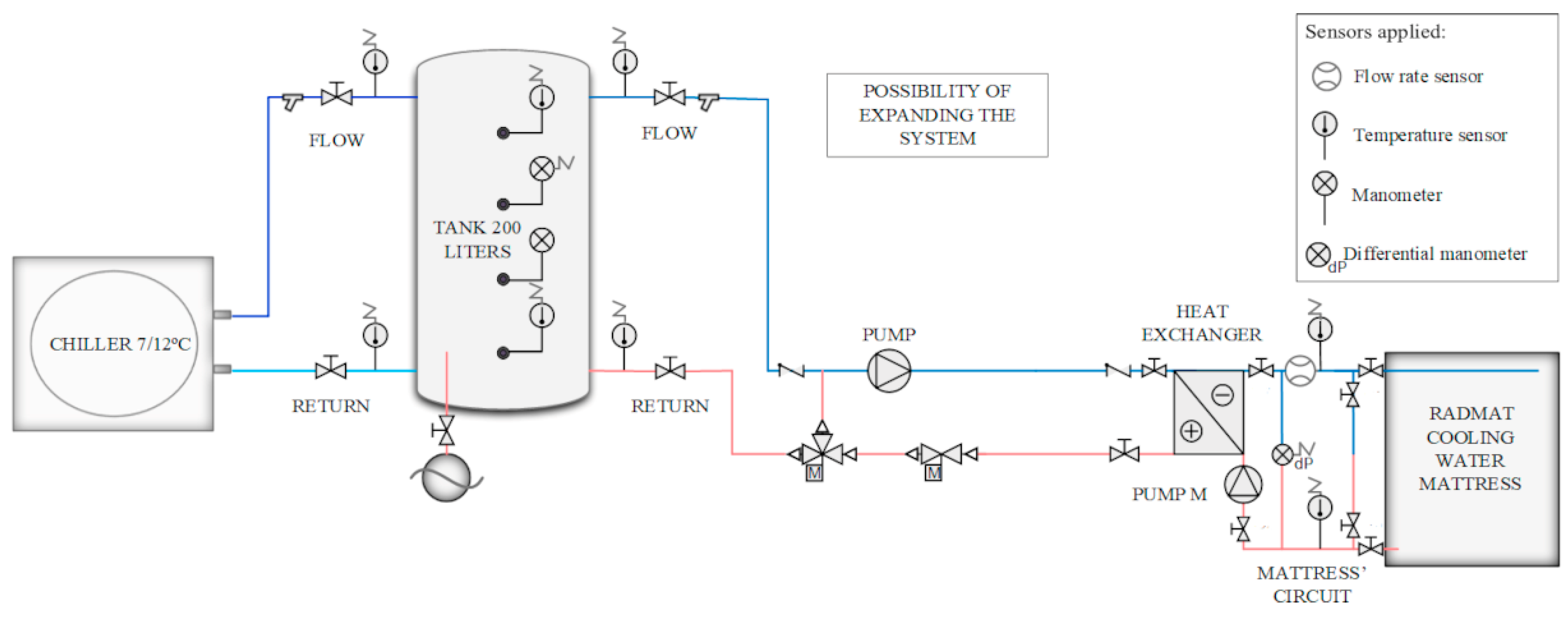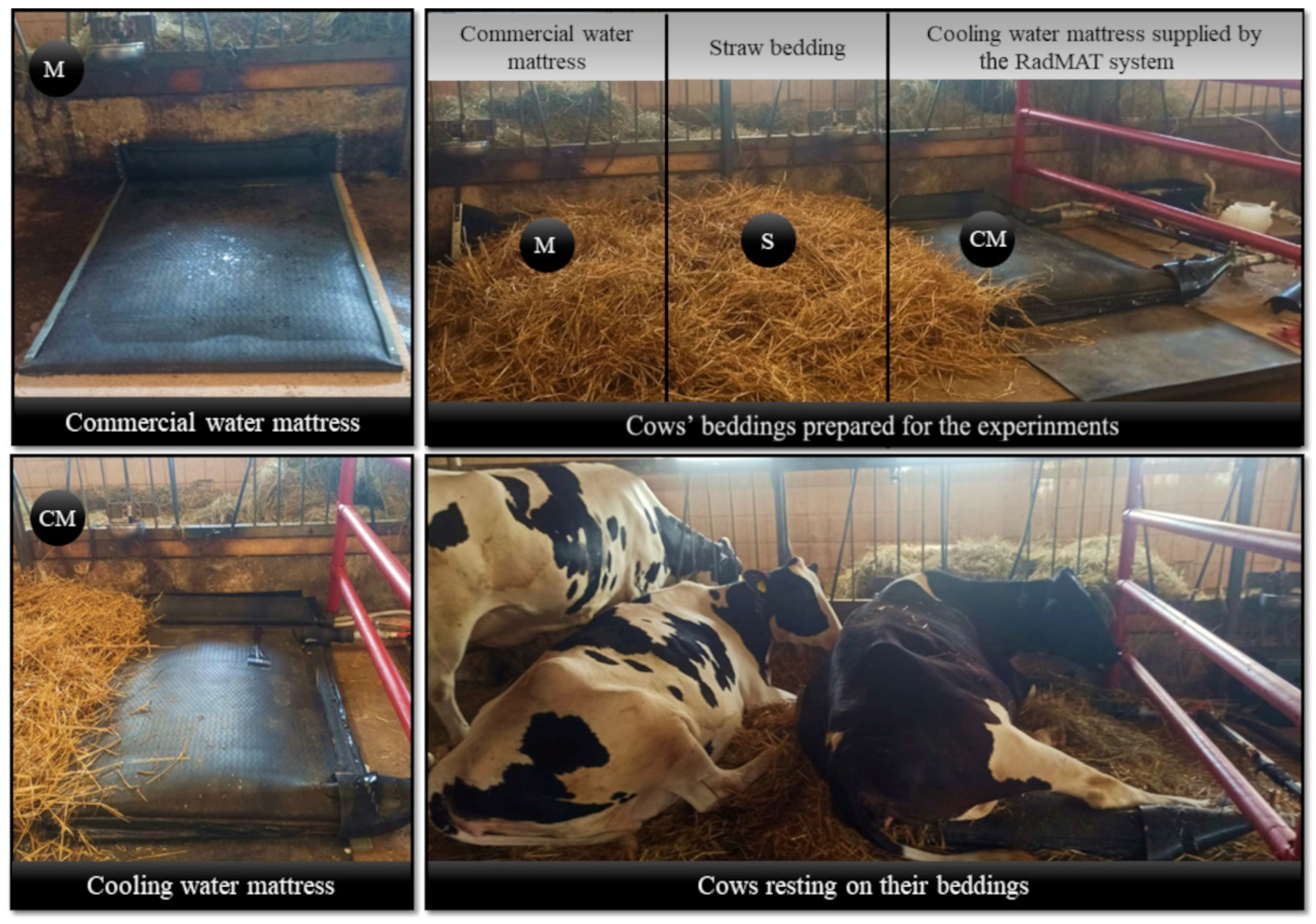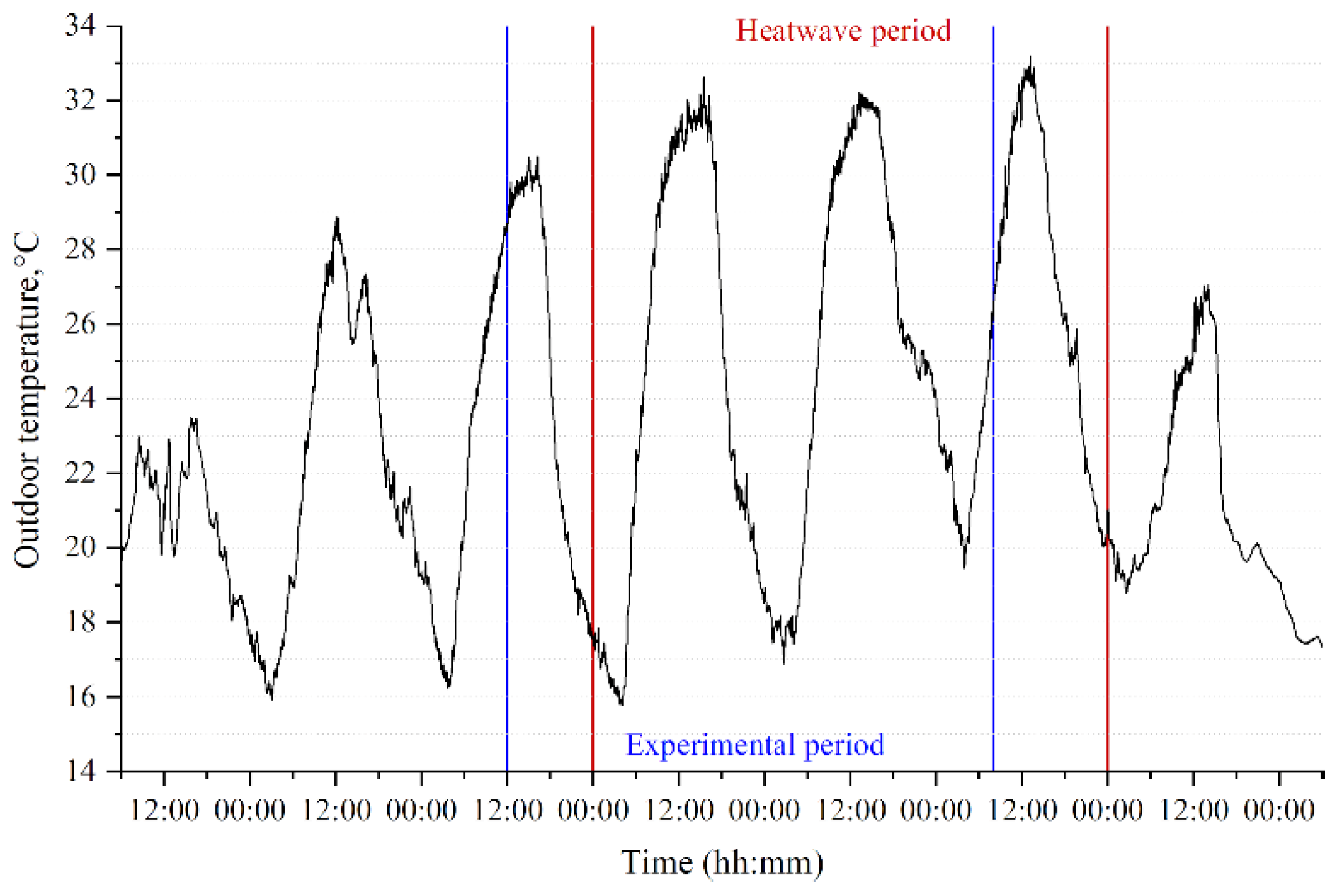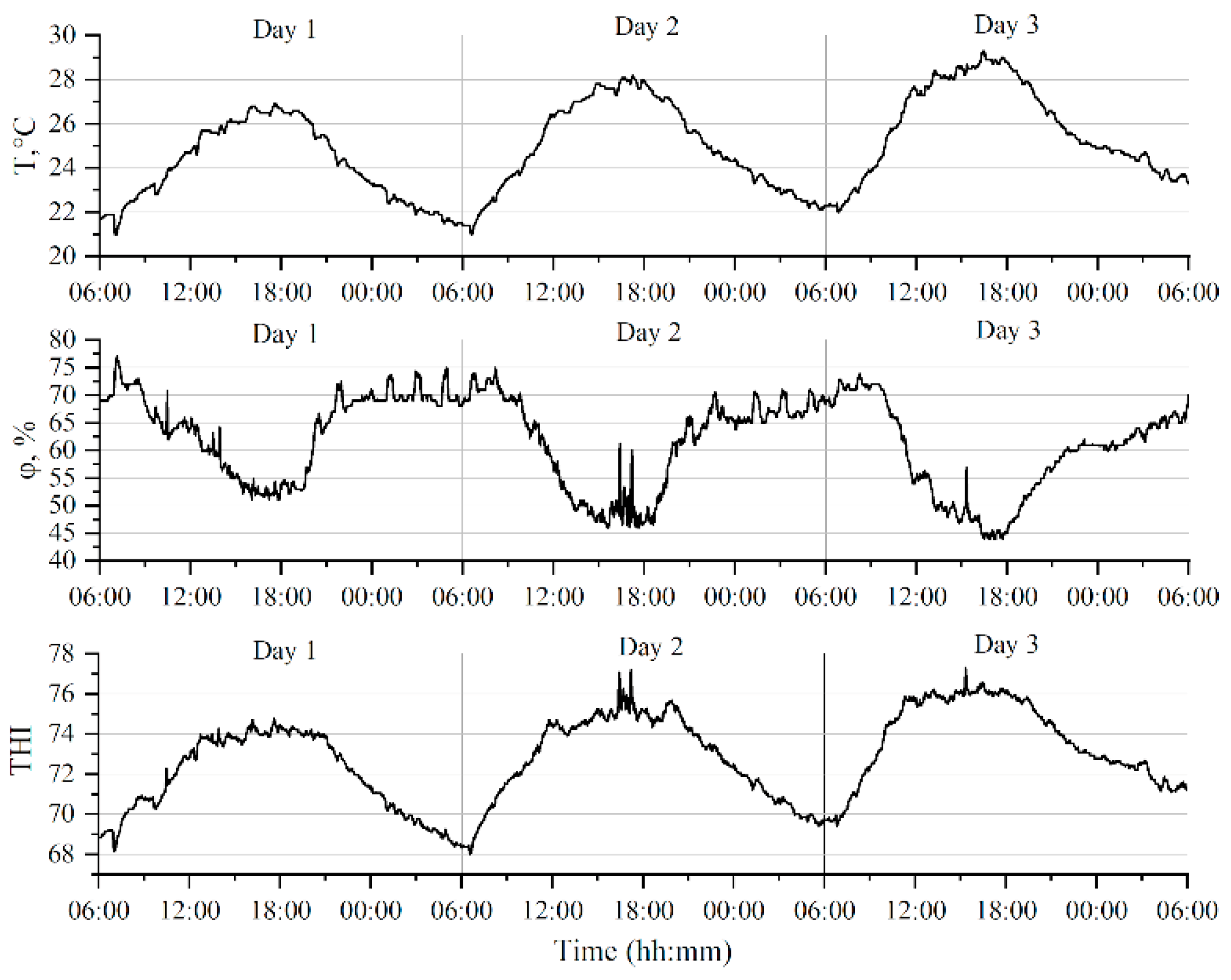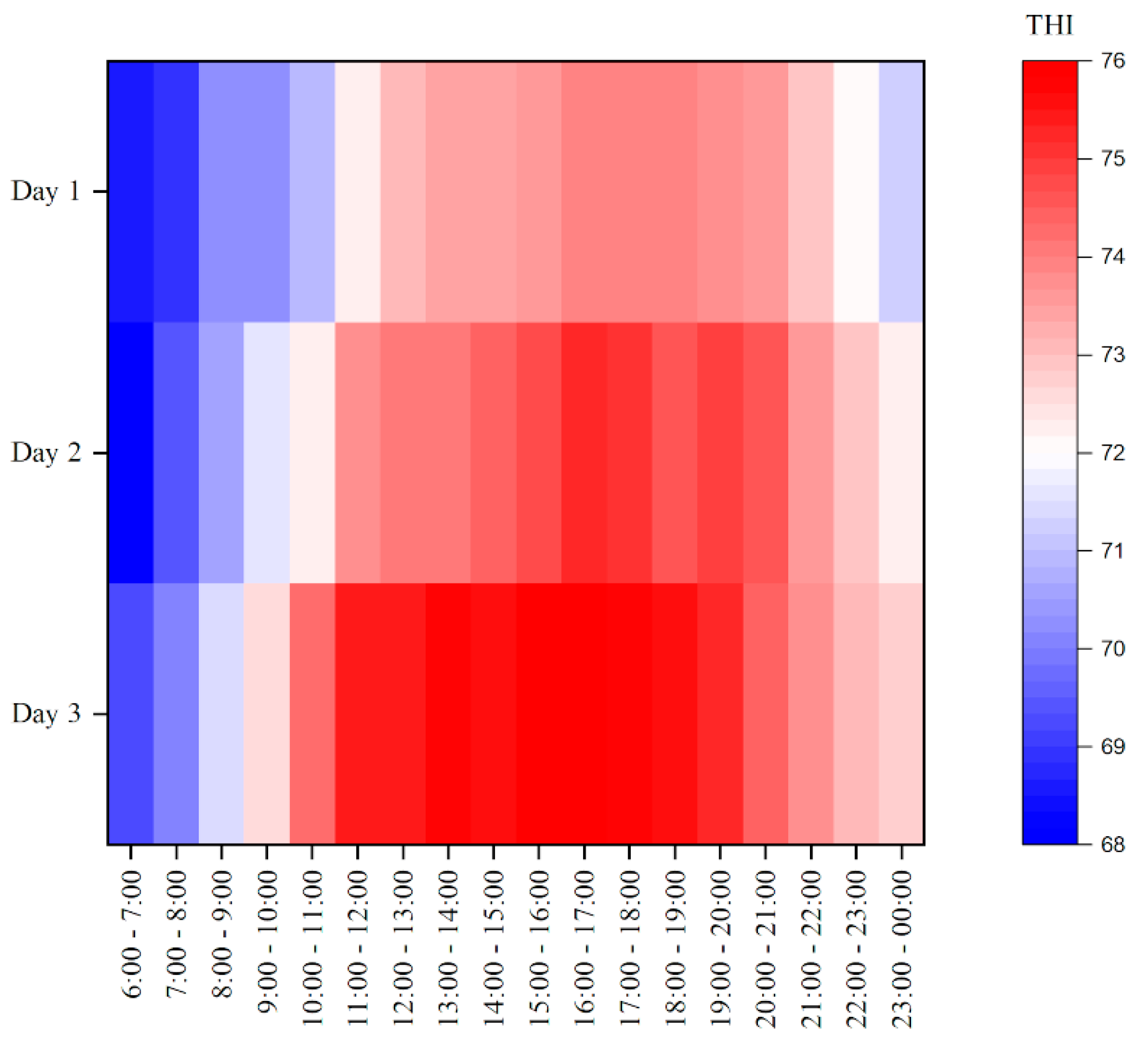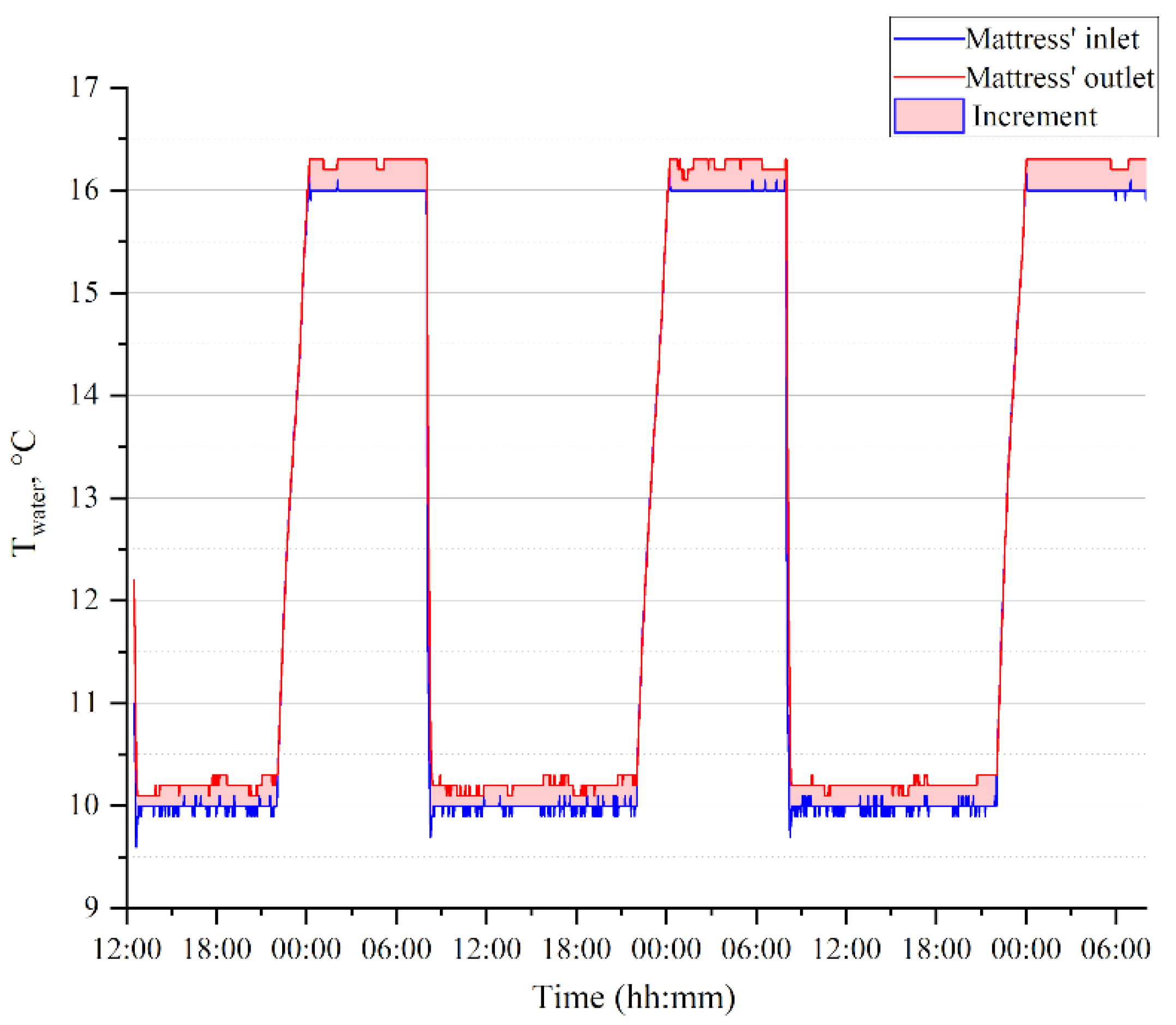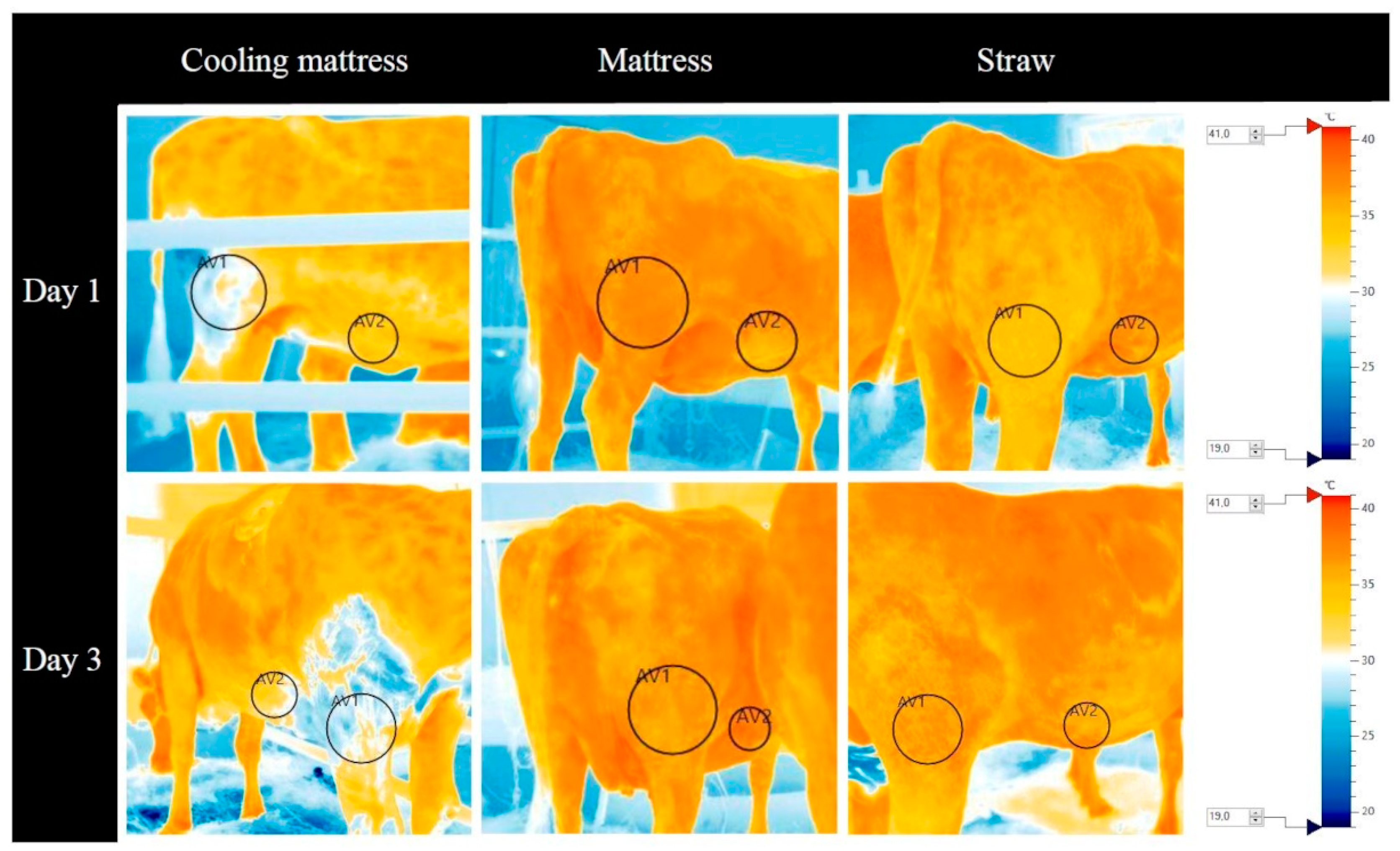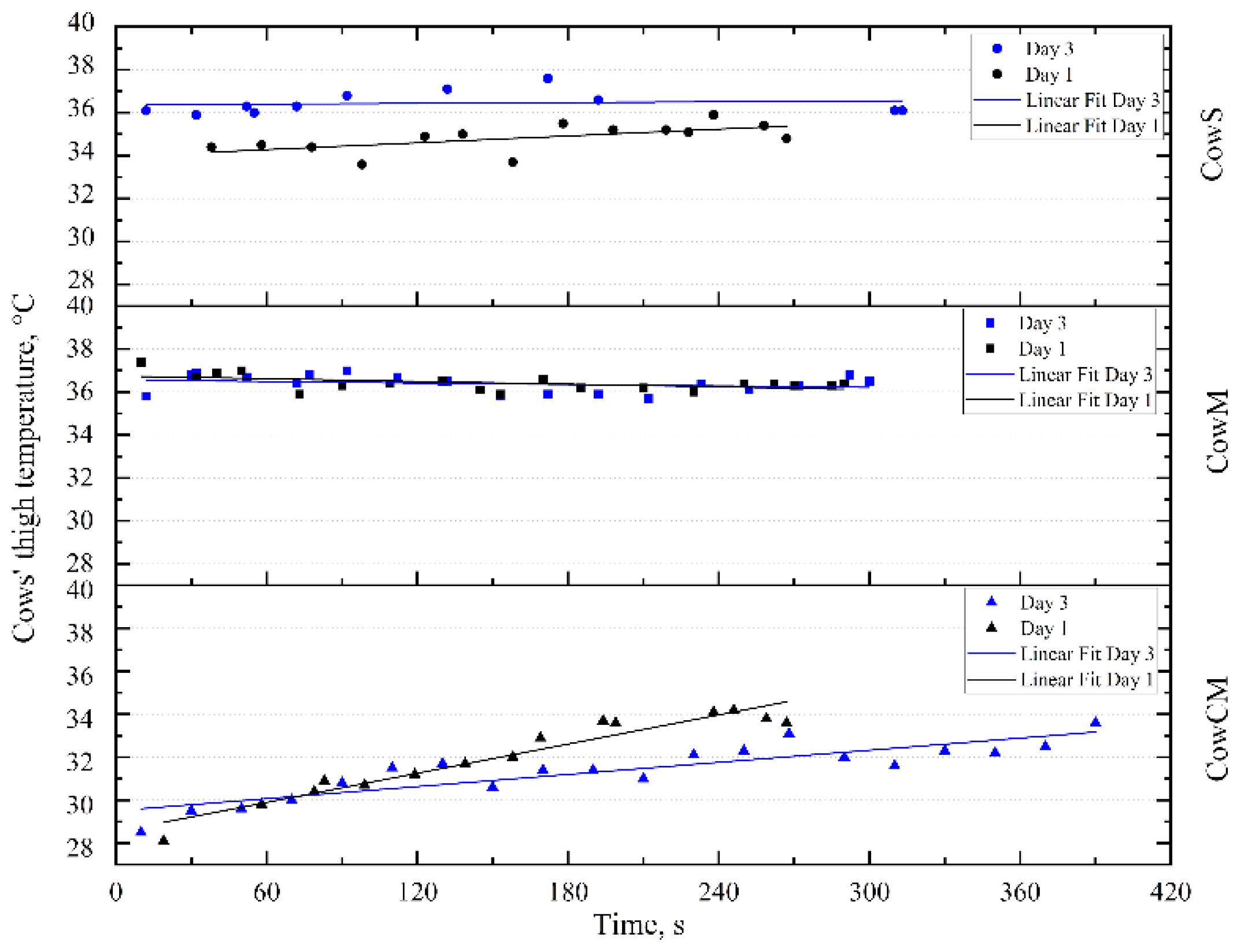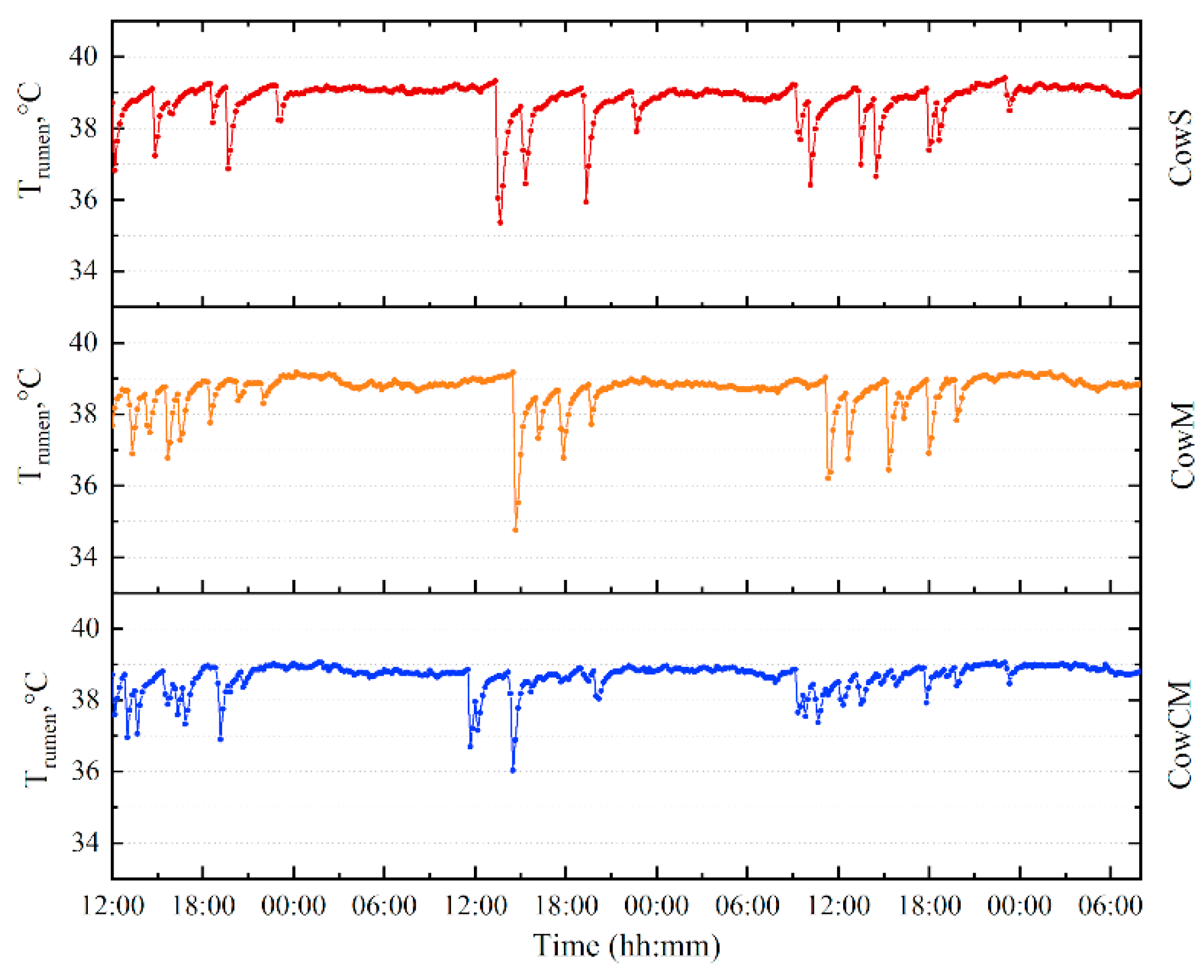1. Introduction
A significant increase in the average temperature in Europe since the 1990s is observed, making it the fastest-warming continent of the World Meteorological Organizations regions [
1]. Moreover, recorded heat waves have become more repeated and severe. Weather heat extremes have profoundly adverse consequences on everyone’s day-to-day life and economic activity in many parts of the world, including Poland, the central European country involved in this article.
Daily life in livestock farming is affected by excessive heat, and not only during heat waves. A cow becomes heat-stressed when she produces more heat than her body can passively dissipate to the surrounding environment. A temperature range within which adult animals can maintain a normal body temperature and have a comfortable microclimate is called the thermoneutral zone. For cattle it ranges from 16 °C to 25 °C and in these conditions the dairy cows can maintain their physiological body temperature of 38.4 °C-to-39.1 °C [
2]. In the above-mentioned conditions the animal is continually challenged and stressed beyond its physical capacity to cope. In turn, this can cause changes to the immune system, leading to increased disease susceptibility, poor growth, and reduced production [
3]. An important consequence of extreme temperatures is also a change in the animal’s behavior through prolonged standing time, reduced dry matter intake, as well as increased internal body temperature and respiration rate [
3].
Ambient temperature is an important factor affecting heat stress in cattle but environmental humidity is also affecting the severity of heat stress. Therefore, the Temperature Humidity Index (THI) is the most widely used environmental indicator of the effects of heat stress in the livestock sector. This index combines air temperature and humidity, two main parameters that influence cows’ well-being, enclosed in one index. The heat stress threshold has been set at daily THI values of 68–72, depending on the formula used according to scientific articles. Zimbelman et al. [
4] used Buffington et al.’s formula and their studies indicated that adverse effects could occur at a THI level of 68. Herbut and Angrecka [
5] used the National Research Council formula and the first losses in milk production were observed when the THI reaches 72 and the highest decrease was observed when the THI is in the range of 76–78. Depending on the THI formula, calculations can be based on the dry bulb temperature, wet bulb temperature, relative or absolute humidity, or the dew point temperature [
6]. Selection of the proper formula for the prevailing climate is highly important for results analyses.
Cattle breeders striving for efficient and regular production try to protect their herds from high temperatures. Depending on the local climate, this may include the provision of shading, air movement by fans [
7], feed-line soakers, misters [
8], and, currently popular, combination systems of misting fans [
9,
10]. Domingos et al. [
11] conducted experiments that clearly show the effect of providing shade and frequent spraying of water on cows’ milk yield. However, these solutions did not prevent a positive thermal balance in the animals. Chen et al. [
12] have shown that the combined system requires appropriately adjusted regulation that considers the external environment’s current conditions to be most effective. The effectiveness of reducing the heat stress of the accessible solution is influenced not only by the efficiency of the system itself but also by the speed and direction of the air, as well as the position of the animal [
13].
Commercially available cooling solutions consume large amounts of water and electricity; moreover, the implementation of an appropriate cooling system is essential for proper decision management in dairy farms, improving the animals’ thermal comfort and welfare [
14]. To solve this problem, researchers are looking for new cow-cooling methods. Bastian et al. [
15], as the first study on this topic to the authors’ knowledge, observed that a cow lying on a waterbed could give off its heat. The chilled water temperature setpoint of 10 °C was tested and the data from the experiment were used to create a model of heat loss by conduction. Ortiz et al. [
16] evaluated the use of a heat exchanger supplied by chilled water at a temperature of 7 °C, located under 25 cm of animal bedding as part of a cooling system for dairy cows under controlled environmental conditions. They observed a decrease in core body temperature, respiratory rate, and skin temperature, pointing out that the cooled cows consumed more dry feed and produced more milk. Perano et al. [
17,
18] studied a conductive cooling system for heat-stressed lactating dairy cattle. The observation of the animals during experiments using the two different temperature setpoints of 10 °C and 4.5 °C was carried out. The influence of the thickness and type of bedding on the value of the heat flux was also determined.
The aforementioned studies indicate that work related to conduction cooling is still at an early stage and requires further development. The usefulness of the proposed solution is visible also in cows’ time spent in a lying position, whose range is between 8 and 16 h a day [
19]. Furthermore, conduction cooling is a precision cooling system for cattle, delivering cooling exactly where it is needed. Zhang et al. [
20] summarized the existing precision cooling technologies and pointed out that this area still requires more research and work.
Sustainability in the dairy, livestock, and agricultural sectors is now an ongoing topic in research in an era of global warming. A Canadian study [
21] comprehensively focused on sustainability strategies, ways to reduce greenhouse gas emissions, and ways to manage the barn and its resources while maintaining animal welfare. Moreover, new sustainable cooling solutions are constantly being developed that could be used in the livestock sector in the future. These include earth pipe cooling [
22] or the direct-contact air, gravel, ground heat exchanger [
23].
The main aim of our study was to confirm the cooling effectiveness of the proposed conductive cooling solution based on the example of experiments carried out in Poland. Subsequently, the introduction of a new sustainable cooling solution based on thermal conduction, as a potential for implementation in the dairy sector, was the parallel (equivalent) goal. The innovation of the solution uses a unique geometry that allows a uniform distribution of chilled water temperature inside the mattress, which was analyzed by Computational Fluid Dynamics-based simulations [
24].
The final aim of this experiment was to prove the potential of the proposed conductive cooling system in heat stress mitigation. Following that goal, we put forward the research question: whether changing the supply of chilled water temperature of the cooling water mattress twice a day would be sufficient to affect the rumen temperature of the cow and its behavioral response in the conditions of diurnal air periodical temperature increase.
2. Materials and Methods
2.1. Developed and Applied Cooling System
The proposed cooling system consists of two main subsystems: an innovative cooling water mattress module and a chilled water production and distribution system. The design of the water mattress handling module was selected among four propositions analyzed in terms of heat transfer by applying the Computational Fluid Dynamics-based simulations in the Ansys Fluent environment. Furthermore, in the decision-making process authors considered also the influence of the design on animals’ well-being and its technical challenges. The chosen and developed design in the present study is based on modifying the commercially available water mattress for cattle in a way that ensures a stable and even flow of coolant through its interior. For that purpose, the water distributor and channel structure were applied inside the mattress. The 3D geometry of the module developed in Autodesk Inventor Professional 2020 Software is presented in
Figure 1. It was implemented in the Ansys Meshing Module, where tetrahedral mesh was generated. For the simulation, the inlet water temperature of 4.5 °C and mass flow of 0.85 kg/s were assumed. The model of heat transfer between the animal and mattress surface was simplified to the surface temperature boundary conditions and assumed as 35 °C, being the temperature of a cow’s skin. In model calculations, for the fluid domain the k-ε realizable turbulence with enhanced wall treatment was employed. As a result, the 715 W/m
2 heat flux was achieved. More detailed information about the modeling process has been described by the authors in [
24].
Implementation of the design into a prototype was achieved through the 10 rubber fenders shaping the channel structure inside the mattress. Each fender is 1.3 m long, 43 mm wide, and 25 mm high, spaced every 45 mm from the edge. Water is supplied directly to the channel through a distributing collector with a diameter of 50 mm and 9 orifices with a 10 mm diameter. The collection of the returning water is realized through the 50 mm return collector. The water mattress is placed on a layer of 2.5 cm-thick plywood fixed to the steel frame. The water capacity of the mattress ensures proper cushioning for the cows’ body weight.
Figure 2 presents the innovative cooling water mattress and its supplying cooling system.
The cooling water mattress is supplied with chilled water produced and distributed by the RadMAT system presented in
Figure 3. It consists of two water circuits but can be expanded with another two in the future. The first water circuit is connected with the 200 L chilled water storage tank to accumulate cold water produced by the Frimec MGC-V5W/D2N1 chiller with a 5 kW cooling capacity (FRIMEC International, Meru, Selangor, Malaysia). It is coupled through the Alfa Lava CB30 heat exchanger (Alfa Laval Corporate AB, Lund, Sweden) with the cooling water mattress circuit. Each circuit is equipped with a water circulation pump (Ecocirc XL 32-80) (Xylem Inc. Washington, DC, USA) coupled with variable speed drivers. The temperature and water flow at the inlet to the water mattress are measured with a Vortex SV7204-SVR34XXX50KG/US-100 (ifm electronic gmbh, Essen, Germany) flow meter (accuracy rating ±2%) equipped also with a temperature sensor (accuracy rating ±1 K). The water mattress outlet temperature is recorded with an ifm TA2115 (ifm electronic gmbh, Essen, Germany) temperature sensor (accuracy rating ±0.1%). Furthermore, an electric three-way valve enables supplying and returning water blending for temperature regulation. The operation of the system is controlled with Supervisory and Control Data Acquisition.
Inspired by other works of various authors in the fields of dairy welfare [
15,
16,
17], the following chilled water setpoints were selected: temperature of 10 °C during the day (from 8:00 to 22:00), 16 °C during the night (from 22:00 to 8:00), and a flow rate of about 1.6 m
3/h. The selected time frame for each setpoint is justified by the animals’ feeding and management time in the morning hours and thermal conditions in the barn during the evening hours. The innovative cooling water mattress’ inlet and the outlet water temperature were continuously monitored and recorded.
2.2. Animals and Experimental Design
This experiment was conducted in the Research and Didactic Station in Swojczyce (51.11° N, 17.15° E), which is a part of the University of Environmental and Life Sciences in Wrocław, in the period 16–18 August 2022. Preliminary research was carried out with three milk-breed Friesian dry cows, which were approximately 5–6 years old. The number of units was justified by the already-applied tie-stall housing system and health control reticulorumen bolus sensors for those animals. The decision-making process was based on the least interference in the animal’s daily routine and well-being.
The animals were housed in a barn equipped with natural ventilation, and no applied automatic regulation of any environmental parameters. Within the entire test duration, all animals had constant access to drinking water and were fed “ad libitum” twice per day at approximately 08:00 and 14:00. Since they were not lactating cows, the pasture was hay. As the element of the cows’ routine management in the selected barn, each cow was observed daily for signs of sickness or discomfort by the zootechnical staff of the aforementioned research station. This study has been evaluated in accordance with current European legislation (directive 2010/63/UE) (the European Parliament and of the Council, 2010). During the experiment, no procedure that could cause pain, suffering, or distress was used. Only the environmental indicators and bedding parameters were measured, and for the assessment of animals interference was limited to a minimum by using previously applied reticulorumen bolus sensors (protocol No. 053/2019).
Each cow was lying down on a different type of bedding: the types proposed in this paper were the innovative cooling water mattress (CowCM), the commercially available commercial water mattress (CowM), and straw bedding (CowS). Using different types of beddings enabled comparison of their influence on animals’ thermal comfort. The cows’ assignment to the bedding was justified by technical and logistic reasons in the prototype cooling system application in the selected barn’s infrastructure. It should be highlighted that cows resting on water mattresses had spent the previous 3 days acclimatizing to the new beddings before the initiation of the analyzed experimental period. The applied acclimatization period was indicated by the Guide for the Care and Use of Laboratory Animals [
25] as the minimum recommended time period before minor procedures, which was considered sufficient since no invasive procedure was applied. Due to the fact that the proposed cooling water mattress was developed as a modification of the commercially available water mattress, the same model was selected as the reference to the conducted experiments. Commonly used straw was considered as the third type of bedding and the second reference used to estimate the cooling effect of the proposed cooling water mattress. Following the manufacturer’s recommendation, the commercial waterbed was filled with water, and assembled with latex foam. Both mattresses were also provided with filled water kneeboards placed on the top of the mattress. All three bedding types applied during the experiment are presented in
Figure 4.
During all measurement days, the mattresses’ surface temperature was measured in three locations: bottom, middle, and top. The measurement took place approximately every 1 h (between 9:00 and 18:00) and was carried out by a Visiofocus 06620 (Tecnimed, Vedano Olona, Italy) thermometer (accuracy rating ±1 °C). The developed water mattress was continuously (24 h per day) driven by cooling water and monitored by a set of sensors, which collected a substantial number of records.
2.3. Environmental Indicator of Heat Stress
Environmental conditions inside and outside the barn, including the temperature and relative humidity of the air, were continuously measured with a 2 min sampling time using the meteorological station, equipped with an NTC AKO015561 (AKO, Barcelona, Spain) ambient temperature sensor (accuracy rating ± 1 °C) and a SONEE16F6A21 (Pego, Rovigo, Italy) relative humidity sensor (accuracy rating ± 3%). The sensors were installed at about 1.5 m from floor level. Collected data were used to designate the Temperature Humidity Index (Equation (1)) as the environmental heat stress indicator during the experiment.
The THI was calculated according to the National Research Council formula [
26]:
where
2.4. Rumen Boluses
The body temperature of each cow was continuously monitored by smaXtec reticulorumen bolus sensors (smaXtec animal care GmbH, Graz, Austria) (accuracy rating ±0.05 °C) to assess the thermal reactions of animals’ bodies to the applied cooling system. This system enables the monitoring of the activity, drinking behaviors, and detection of feverish conditions, and estrus via heat index parameter, every 10 min. As a result, 1230 recordings (410 for each cow) were collected for the experimental period. Additionally, based on the same temperature data, the drinking parameter was determined as the summarized number of records under the 38.1 °C threshold adopted by Vázquez-Diosdado et al. [
27].
2.5. IR Thermography
IR thermography with a Testo 890 (Testo SE & Co. KGaA, Titisee-Neustadt, Germany) thermal imaging camera (accuracy rating ±2% of m.v.) was used to verify the direct cooling effect of the developed water mattress. On the first and last day of the experiment, 5 min videos of all three cows were recorded with the above camera once the cows got up from the bedding. The videos were recorded after the studied cow had rested for about one hour. The time interval depended on the cow’s individual predisposition and reaction. The thermographic videos were processed using testo IRSoft 4.8 SP1 software. Data collection from those videos required applying a uniform methodology consisting of several steps. First, the thermograms were extracted from the analyzed video with a sampling time of 20 s. Additional thermograms were also extracted if there was a need for additional data from the considered shot. Finally, 104 thermograms were analyzed in terms of the view on the cow’s thigh and abdomen. The values of ambient air temperature and relative humidity measured on-site at the time of thermography have been taken into account and entered into the IRSoft software. Each mentioned area was marked with the same diameter assigned to this previously selected region on all thermograms to designate the average temperature, hot spot, and cold spot. Areas with minimum and maximum temperatures were marked to indicate whether they showed the same trend as the average values. The selected emissivity of 0.79 was chosen based on the publication of [
28], who conducted studies to determine emissivity for a number of mammal species, including the Friesian cow. Finally, all calculated IRSoft software values were further transferred, analyzed, and visualized.
2.6. Behavioral Observations
The animals’ behaviors as an indicator of animal welfare were continuously monitored by an IMX477 camera for Raspberry Pi—ArduCam B0241 (ArduCam, Nanjing, China). Behavioral observations were made on the basis of recordings using the Noldus The Observer XT 16 software (Noldus Information Technology BV, The Netherlands, Wageningen). The time considered for the behavioral analysis of animals and determining their time budget was set from 06:00 to 18:00 (720 min). During the observation, the following continuous behaviors were recorded: lying, standing duration, grooming, and self-grooming. On the first day of the experiment, due to the test-stand modification, CowCM was absent from the cooling water mattress and the camera’s monitoring area between 8:00 and 11:00. In the time budget analysis, this period was assigned to the standing duration, on the basis of direct observation of behavioral patterns connected with the routine feeding time at 8:00. Night observations were excluded from the analysis due to the poor visibility in the recordings. Point behaviors, i.e., the frequency of shaking the chain, licking solid materials, self-grooming, grooming, kicking and lying, and standing bouts, as indicators of animal welfare, were also recorded. Grooming means grooming behavior toward another individual in the herd. Continuous behavior data were compiled as a total amount during the day, and the mean duration according to lying/standing bouts.
2.7. Statistical Analysis
The reticulorumen temperature data obtained with continuous recordings were analyzed using a general linear model for repeated measures of two-way ANOVA with treatments and sampling time in the STATISTICA 10.0 software (StatSoft Inc., Tulsa, OK, USA). The analysis had been preceded by screening all data for normality with the ANOVA procedure. Statistical analyses were conducted individually for the diurnal recordings (between 8:00 and 22:00, except on the first day, when the experiment started at 12:00) and nocturnal recordings (between 22:00 and 8:00). Results were presented as average values, accompanied by the standard error of the means. The significance of the differences between the test results was determined by Tukey’s test. Significant differences between the reticulorumen temperatures of examined cows were declared at the standard statistical level of p < 0.05. The animal’s time budget was statistically analyzed using a t-test for a single try in Statistica 13.0 software (StatSoft Inc., Tulsa, OK, USA). The procedure has been proceeded with a visual screening of the residuals in terms of normal distribution. In the applied methodology, the mean values of individual SE behaviors and p-values were obtained. Significant differences were also established at a standard statistical level of p < 0.05.
3. Results
The results presented in the following subsections are oriented in three main areas of further interpretation: environmental conditions, the cooling water mattress in various environmental conditions, and the cow’s response to the novel cooling system.
3.1. Environmental Conditions
In order to observe long-term weather conditions to which the animal needed to adapt during the experiment, the outdoor temperature profile, recorded by the meteorological station located in the Research and Didactic Station in Swojczyce, is drafted in
Figure 5.
Environmental conditions that determine a cow’s thermal comfort are defined by ambient temperature and relative humidity of the air, and expressed by the THI.
Figure 6 presents these parameters as the function of time. Due to the low susceptibility to change of the THI within one hour, its average value in the hourly time frame is also presented as the heatmap in
Figure 7.
3.2. The Cooling Water Mattress in Terms of the Natural Daily Cycle of the Barn
The continuous operation (24 h per day) of the RadMAT system with the innovative cooling water mattress module was tested for naturally changing environmental conditions, following the animal’s day routines. The influence of the thermal conditions on the cooling water mattress was also continuously monitored with the water mattress’ inlet and outlet temperature sensors. The characteristics of the aforementioned parameters together with the plotted difference between outlet and inlet temperature are presented in
Figure 8. It can be observed that inlet water temperature was maintained on two levels— diurnal 10 °C and nocturnal 16 °C—following the setpoints. A temperature increment between the outlet and inlet indicates the heat transfer between the animal and chilled water. Its narrow value indicates a uniform temperature distribution among the mattress, following the primary assumption [
24]. Moreover, it is strongly connected to the high water capacity of the cooling mattress, which requires a long-lasting period to be warmed up significantly, especially when it is continuously supplied with chilled water.
The surface temperature of the cooling water mattress and the commercial water mattress, measured pointwise by a Visiofocus 06620 (Tecnimed, Vedano Olona, Italy) thermometer, is presented through relative bars in
Figure 9. It can be observed that although both surfaces were at stable temperature levels throughout each day of the experiment, the temperature difference between them increases slightly with the increase in the THI during that day. The surface temperature of the cooling water mattress exceeded 16 °C, being almost twice lower than the commercial water mattress. The temperature increment of about 6 °C between cold water and the mattress surface was connected with the heat transfer insulative properties of the rubber. On the other hand, Ortiz et al. [
16], who proposed conductive cooling through the heat exchanger, highlighted the problem with a thick layer of sand, necessary in this solution, which greatly restricted the heat transfer from the animal. Therefore, the proposed cooling water mattress avoids such a reduction in the heat transfer properties and allows for economic savings on the regular replacement of a thick layer of litter.
3.3. Cow’s Response to the Novel Cooling System
The cooling effect of the water mattress was also monitored through the evaluation of the cow’s behavioral reaction, as well as skin temperature measurements of selected body regions, monitored with IR thermography, and finally the rumen temperature of the studied animal. Thermograms showing the thigh and abdomen area taken 1 min after the animals got up from the bedding area are presented comparatively in
Figure 10. The average skin temperature for the thigh and abdomen, which were in direct contact with the chilled surface, was reduced even by 8 °C compared to the cows lying on the reference beddings (CowM and CowS).
Cows’ skin temperature variability within the thigh and abdomen area over 7 min after they got up are presented in
Figure 11 and
Figure 12, respectively. The results for each cow are linearly fitted. The thigh temperature plots of the cow lying on the cooling water mattress are characterized by a much lower temperature at the beginning of the considered 7 min-long time period and by a high increase during this interval, in comparison to the results achieved for two other referenced cows.
Another considered parameter is cows’ reticulorumen temperature (
Table 1). In the conducted experiment, the rumen temperature of examined cows, considered as the main trend presented in the
Figure 13 curve, was slightly oscillating around 39 °C, which is a natural value [
29].
According to
Figure 13, the characteristics of the temperature drops for CowM and CowS remained similar among the experimental days, but for CowCM the temperature difference in each drop was smaller in the following days of the experiment. On the last day of the experiment, which was characterized by the highest THI (c.f.
Figure 7), temperature drops were more frequent than in other cows, but achieved a maximum value of 1.2 °C, contrary to 2.3 °C and 2.8 °C for CowS and CowM, respectively. Counting the mentioned temperature drops according to the applied methodology, the highest value of the drinking parameter was observed for the cow lying on straw bedding (CowS was 36 times vs. 28 times in the case of CowCM). A stable profile of the temperature around 39 °C can be observed in the nocturnal hours of the experiment.
Behavior was another aspect taken into account for cows’ welfare evaluation. For that assessment, the time budget of experimental cows, which includes time spent on standing and lying, was designated and summarized in
Table 2, together with SE and
p-values calculated for the average values of individual behaviors. The frequency (bouts) of these activities were also counted.
Supplementary Materials provide additional data about cows’ behavioral preferences. The bouts number may vary depending on considered time, environmental conditions, bedding type, and individual behavioral patterns.
During the first day of the experiment, the lying time did not differ statistically between animals; however, on that day CowS spent 45% of the time budget on lying, which is the highest percentage recorded for the experiment. This value drops to only 26% on the third day of the experiment and becomes statistically significant (
p < 0.05). A similar relation was observed for the cow lying on the cooling water mattress (CowCM), for which the lying time was reduced from 26% on the first day of the experiment to 14% on the last day of observation (
Supplementary Materials Figure S1).
An inverse relation in lying behavior was observed for CowM, for which lying time increased from 18% on the first day to 24% on the third day of the experiment. However, the relatively short duration of the experiment, as well as the individual behavioral patterns and habits of each animal, make these data difficult to interpret precisely. Therefore, behavioral observations need to be extended for a longer experimental period.
The frequency (bouts) of lying activity was also statistically significant with p < 0.05, and its value increased between the first and last day of the experiment for CowCM and CowM, and remained the same with the lowest value of 3 for CowS. The same number of bouts was observed for CowCM on the first day of the experiment, with an increase to 5 on the third day of the experiment. The greatest numbers of lying bouts—5 and 7—were observed for CowM. An increased number of lying bouts with a reduced mean lying time for this animal as well as, as described previously, its rumen temperature and drinking parameter characteristics, indicated the cow’s need for short but more frequent cooling episodes and maintaining rumen temperature at a more stable level, which encourages the validity of this thesis. However, it needs to be verified by more experiments conducted for different water temperature setpoints and environmental conditions.
Point observations were also under observation (
Table 2). The two common behaviors were detected in the experiment: grooming and self-grooming. Observed behaviors did not differ statically between the animals. Furthermore, stereotyped and aggressive behaviors, including chain shaking and kicking, were not observed in the experiment.
5. Conclusions
In summary, this article brings together the cooling water mattress technology to provide a solution for dairy industrial applications, providing thermal stress relief. Such an approach has not yet been attempted for Polish dairy industry applications. The conducted study proved a high demand for such a solution, due to the moderate heat stress conditions and heat wave occurrence that burden cattle in current Polish climate conditions. The developed system reduced the animal’s skin temperature by up to 8 °C, which was confirmed by IR thermography. Moreover, a significantly lower (p < 0.05) internal temperature (reticulorumen temperature) was recorded for a cow cooled with the mattress compared to reference cows, which indicates a high potential in alleviating heat stress even during short-term use. However, the studied results indicated the need for adapting the water temperature setpoint to changing ambient conditions and thermoregulatory mechanisms of the animal that accompanies them. Future research will concern the selection of working parameters, system operation sequence, and potential innovation to enhance cooling in dairy cows. Due to the control flexibility, the presented solution has great potential as a novel cooling system, and is tailored to the individual needs of animals, which extends its applicability to each barn-based husbandry system.

